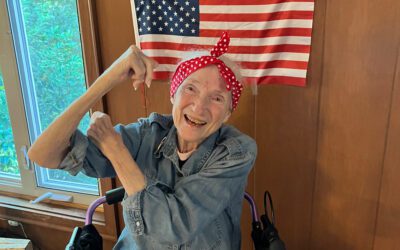[title subtitle=”words: Marla Cantrell
images:courtesy Joel Culberson”][/title]
It’s only Tuesday and already Charolette Tidwell is dealing with a raft of problems. Just days before, the axle on the trailer she uses to deliver food to those in need snapped, and then she looked at the tires on the van that pulled the trailer. Two of the four were bald.
“My accountant worries I’m going to go bankrupt,” Charolette says. And I said to him, ‘It’ll never happen.'” Call her attitude what you like: determination, confidence, hope. But whatever it is, it has served her well through her sixty-nine years. His concern is valid, though. Because Charolette is a radical giver. She uses her pension to help fund the non-profit she runs, Antioch Consolidated Association for Youth & Family, which operates out of an old two-story redbrick building on North 11th Street in Fort Smith, Arkansas and serves as a food bank for those struggling to get by.
Fifteen years ago Charolette had just come off a year of ill health. For her entire life she’d been a dynamo, someone you’d likely call ‘scrappy.’ During her career she’d done everything from nursing to teaching to writing textbooks. But then, during that low spell, her life slowed to a crawl. She told her husband, “I’ve got to get back to work.”
When Charolette makes a statement like that, the world shifts. Years before, at the height of her career at Sparks Health System, she stepped down as Director of Nursing to open a daycare for the children of single parents.
As she talks, her story loops back to the beginning. She came from a big family. Charolette holds up her index finger. “I was never more than this big,” she says, and laughs. “I was a skinny thing, like my mother. And so shy. My mother arranged for us—there were ten—to go to St. John’s Catholic School even though she couldn’t pay. We cleaned the school; that was part of the arrangement. And I saw the nuns give totally of themselves. We were not Catholic; we were Baptists. At home, we were constantly driven to the things of community because my mom required it. My church required it.
“One of my teachers, Sister Pierre Voster, who later became the principal, is now the groundskeeper at St. Scholastica. I called her last week to see how she was and she said, ‘Charolette, just doing what I do.’ She hasn’t changed a bit. She’s outside digging and weeding. Because of her and the other nuns, I got to see giving up close.”
Charolette cites other good influences. There were her teachers at Lincoln High, and later her instructors at nursing school, who helped her conquer her shyness. “I did learn to talk more,” she says. “Now, my kids tell me that when I’m excited about something I won’t shut up. I guess I’ve come a long way.”
Just how far is incredible. Her résumé is filled with honors, as well as a list of degrees, the last of which is a Master of Education from the University of Arkansas.
As she’s talking, the subject of her daycare comes up again. She remembers sitting in her office just before she left Sparks. “David Banks, the CEO and president of Beverly Enterprises (which was the largest long-term care provider in the nation, now Golden Living) called. He offered me a job, and I told him I wasn’t leaving because I was dissatisfied. I was leaving because I needed to do this. He said, ‘What do you know about daycare centers?’ And I said, ‘Absolutely nothing!’ He was just wonderful. He asked me who was funding it and I said I was. He said, ‘Do you know you’re going to go broke?’ And I said, ‘When I go broke, can I come work for you?’ Every month he called me and said, ‘Are you broke yet?’ One day he called and I said, ‘I’m dead broke, David.'”
For seven years she worked for Beverly. She created the company’s first wellness programs, which was an innovative concept at the time. She also started a nursing education department and published textbooks.
Who knows what she would have accomplished next had her health held up. “I’d been on the road for so long. I was never so sick I went to bed, but I did retire in 2000. My husband helped open the Lincoln Youth Service Center, encouraging kids to be excellent, and I’d helped behind the scenes. I remember saying to myself, ‘You’ve been sick long enough. You’ve got to get up and get something done.’ I started handing out food out of the bed of an old truck at the Lincoln Center.
“Michael Helm, who was the president of Sparks and now vice president of my board, saw me down there one day and asked me what I was doing. I said, ‘I’m giving out food.’ I said, ‘Mr. Helm, I need a building. I can’t peddle on the street forever.’ He found Robert Miller, who’s now president of my board, and told him what I needed. When Robert brought me in this building, I cried, because here’s what he said to me: ‘Is this good enough?'”
Nearby, rows of cafeteria tables are covered with grocery sacks. Six volunteers — nobody here draws a paycheck — work methodically, adding canned goods and fruits and vegetables. Before the sacks are delivered, packages of meat will be added. Then they’ll be taken to senior citizens across the area.
“We feed between 6,500 and 7,000 people. We feed the general public who come here. I have a senior mobile pantry. I have at least seven regular volunteers and about twenty-five others I can call to help. My goal right now is to serve more people. That requires buildings, warehouses, transportation.”
Charolette wears a Bluetooth device so she can answer calls and keep going. The phone rings incessantly, until she finally switches it off for a moment. Until now, her story has been mostly reminiscing. But there is an urgency to what she’s now saying.
“Arkansas is lowest on the list for food insecurity. (Food insecurity means people may be missing meals or deliberately eating inferior foods or less than they should.) The lowest. Are we content with that when we know what is essential for living and hoping and dreaming? I’m not content. I’ve seen little old ladies buying cat food to eat. That’s what started the senior pantry. Broke down trailers, van problems, it doesn’t matter, we get there. How in America, with so much opportunity, do we leave people behind? How can we let the people who mentored us, taught us, helped us dream, eat cat food and dog food?”
Charolette says that many believe programs like Meals on Wheels and meals at certain senior centers fill the need when there’s no way they possibly could. She cites the cut in food stamp funding. All of this weighs heavily on her.
Many of her younger clients were fine when the local factories were running at peak capacity. “We used to be a manufacturing comm-
unity. Whirlpool closed. Over 2,000 people were affected. Baldor has cut back. Rheem has cut back. These are the people who need additional food. Most have jobs, one to two of them, but it’s not enough.”
Charolette’s mother taught her the “one helps one” principle when she was just a girl. If one person reaches out to another, and that person does the same, eventually the world changes. Charolette can’t wait for that to happen. And so she does more than her share. She drives an old car. She lives frugally. “I’ll be doing this till the day I die,” she says, and switches her phone back on. It rings immediately. The caller needs help, and Charolette is just the person to provide it.
Arkansas is #1 in both overall food insecurity and child food insecurity. Food insecurity means people may be missing meals or deliberately eating inferior foods or less than they should.
ARKANSAS population 2,959,373
19.7% Overall Food Insecurity Rate
28.4% Child Food Insecurity Rate
RIVER VALLEY OF WEST CENTRAL ARKANSAS population 307,936
(Crawford, Franklin, Johnson, Logan, Polk, Scott, Sebastian and Yell Counties)
17.9% Overall Food Insecurity Rate
30.2% Child Food Insecurity Rate
NORTHWEST ARKANSAS population 478,552
(Benton, Carroll, Madison and Washington Counties)
15.5% Overall Food Insecurity Rate
25.6% Child Food Insecurity Rate
Source: Map the Meal Gap 2015




